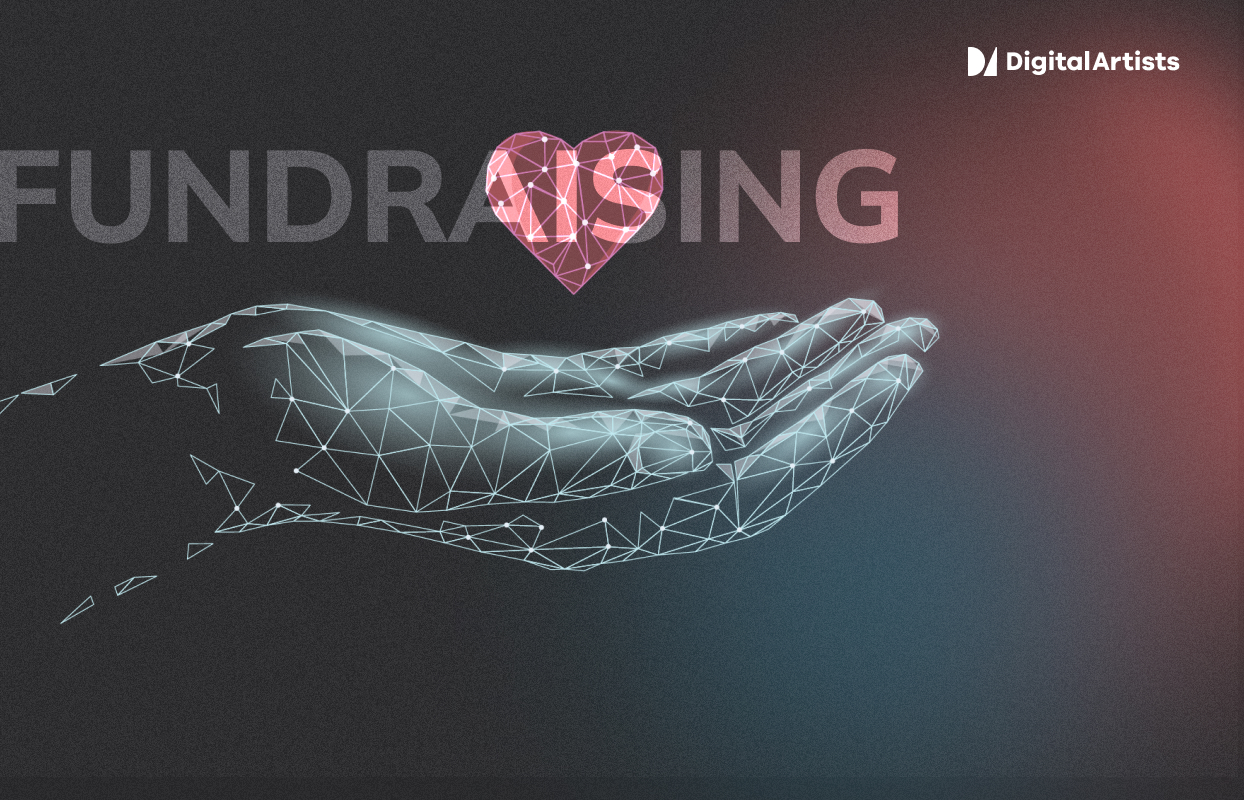


If NFTs used to be a foreign language to most people before, they have now become a common interest for many people who are trying to raise funds for charities and various causes. NFTs saw a spike of interest after single NFT pieces were sold for thousands of dollars, leading to further sales worth millions. Individuals saw this trend as a profitable business idea and started buying and re-selling NFTs.
The NFT market, as of 2023, has been through a notable flow in value, establishing it as a profitable and vibrant sector within the digital economy. It is an ever-expanding market, always welcoming new industries and creators to embrace the potential of NFTs and to monetize their digital assets. Everything from art to virtual real estate, NFTs host a range of collectors and investors. There is a surge in demand that has boosted the NFT market value, introducing new ways to profit from even newer business models.
This article will function as an NFT fundraising guide and as a backbone of fundraising a business whilst exploring various examples of successful cases. It will also explore the benefits and challenges associated with the usage of NFTs for charity and provide insights on how this revolutionary technology can be harnessed for fundraising.
Fundraising has a rich history dating back centuries with records of people supporting various causes related to their communities. Then, in modern society, charitable organizations were established. Nowadays, fundraising has evolved beyond anything our predecessors could have imagined, and it includes diverse method and platforms to enable global impact and social transformation.
This is one of the reasons why NFTs have been implemented into a modern fundraising method. They enable a certain business to directly engage with an audience through auctions and campaigns. They can offer exclusive NFT pieces as rewards or opportunities for people to invest in. Naturally, when people feel included, they are provided with an incentive to be more generous towards a cause that they can truly feel a part of.
There are many factors as to why NFTs have emerged as a powerful way to fundraise, which this article will discuss. There is a constantly growing interest towards this revolutionary way to fund businesses that holds a promising future. In order to truly understand how this could work for you, it is important to look over what exactly NFTs are, how they work and what the pros and cons of using them to fund your organization are.
NFTs, short for Non-Fungible Tokens, are unique digital assets based in a blockchain, a decentralized and public digital ledger that stores information on transactions and ownerships of these tokens. The non-fungible part of an NFT supports the fact that no two NFTs are the same. These tokens represent ownership and authenticity through a unique link in the blockchain.
NFTs come in many forms. They can be art, music, virtual real estate, memes, videos, and pretty much any digital file. Many collections offer NFTs in exchange for a community membership, whose holders are invited to exclusive parties for example.
But NFTs are not the artwork itself. Whilst any online user can right-click and download the same picture that someone paid thousands, if not millions for, only that person who actually bought the NFT can claim ownership of the piece itself. It’s like going to the Belvedere Gallery and buying a print of Klimt’s The Kiss at the gift shop. You can own a copy of the artwork, but not the ownership of the artwork itself. Knowing what NFTs are, it’s now worth exploring the pros and cons of using them for fundraising.
Traditional fundraising has been used by many for a long time, there is history and people have learned the ins and outs of fundraising through it. This would enable both fundraisers and investors to know what exactly they are dealing with and how to deal with it by having tried and tested it over time. These traditional fundraising methods usually have the potential to secure larger amounts of funds and the whole process may be more straightforward to understand and put in practise than the modern ways of fundraising.
The traditional way to raise funds for any organization can be lengthier and sometimes even come with high costs. Organizing events, funding marketing materials and many more aspects cost money to build a charitable event. And another aspect, actually a quite important one, is the geographical limitations that traditional fundraising has. These rely on physical events and local communities to raise funds, preventing an organization’s ability to reach out to global support and a broader audience.
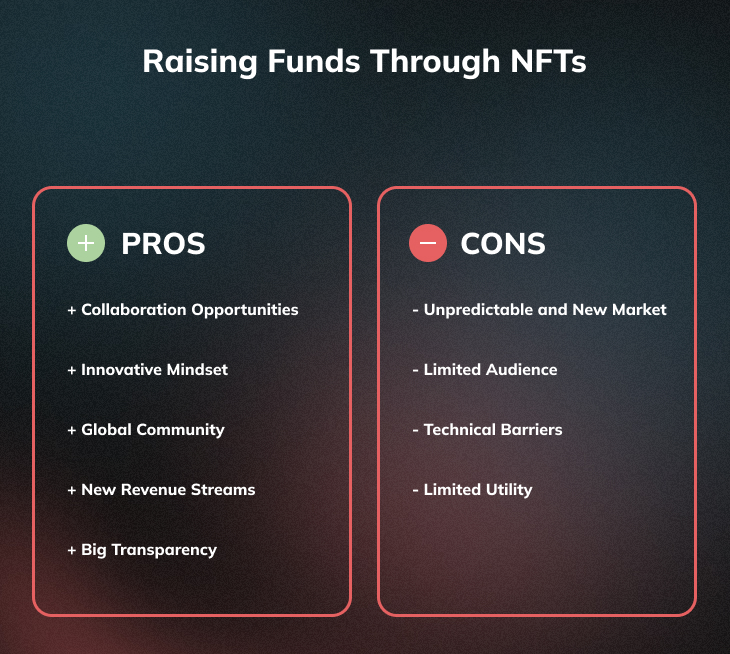
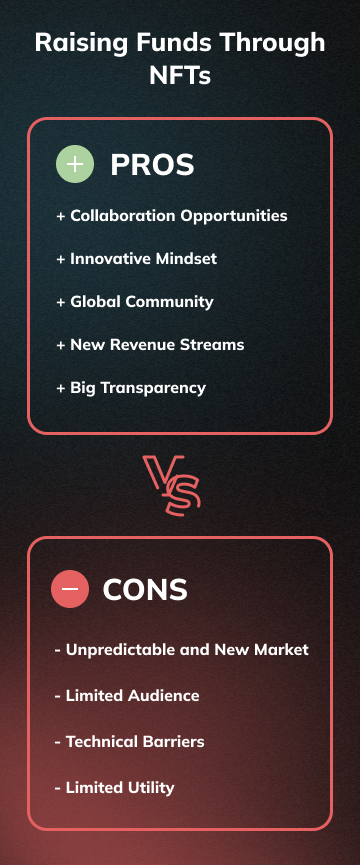
Traditional fundraising itself has pros and cons. A way around all of that is to implement NFTs into your fundraising strategy. With that being said, let’s look at the advantages and disadvantages of using NFTs to raise funds for your business.
Naturally, when doing a fundraising event, people want to see the best outcome and support for their cause. Charities usually exist to support personal stories, the needs of specific or larger communities and respectable charitable causes. When people contribute to such causes, they expect their donations to make an impact, to help with changing an issue. Participants expect that their support contributes towards a solid impact. These can come in many forms and their cause always vary. But the mission is always the same, to help a good mission.
For a charity to be successful, there is a certain expectation of collective generosity and willingness of individuals and communities to support it. This results in a big impact for the cause. Fundraising opportunities usually spread awareness and outreach, and nowadays, an NFT fundraising platform can cover an even wider area. Using non-fungible tokens for any kind of fundraising comes with many advantages.
Based on these examples, it is understandable how any NFT charity auction can boost both the cause itself and bring exposure to the message behind it. After all, it is not necessarily all about money. Artists who share your vision and cause can contribute to creating one-of-a-kind art. Supporters will receive something spectacular in return for their support. And probably most importantly, you will reach an even bigger audience, not just a small community of people, but maybe even the whole world.
Of course, all of this is a new technology to some people, and if not handled carefully, it could become difficult to manage. These advantages can really boost your business through using NFTs, but it’s important to consider the flip side of the whole thing. Let’s look at the disadvantages of using NFTs for a charitable cause.
It might seem too good to be true to have so many advantages to using NFT for charity. While it generally is so, there are some disadvantages that must also be considered when reaching this modern support system.
Some of these disadvantages are only true if the organization allows them to turn to disadvantages. Although the NFT market truly is unpredictable, the respected charity can still use NFTs while the market is stable for successful profit.
There is no way around the environmental concerns, but compared to other industries, the environmental compact that NFTs may have are fairly lesser fractioned. And because this issue exists, many blockchain platforms are looking into the development of energy-efficient blockchain technologies, meaning that there is a better future for the industry.
And lastly, the somewhat limited audience is a debatable topic. It is true that the older generations might not have a chance to donate due to unfamiliarity with the platform, and some of those are quite wealthy and important donators to any charity. But on the flip side, there is quite an enormous (online) community that knows its way with NFTs and can use that knowledge and experience to support charities. As the saying goes – where there’s a will, there’s a way – so both generations can help each other to support a cause they believe in.
Almost anyone can benefit from what this NFT fundraising guide shows. With the right knowledge and experience, NFTs should be an advantage to your business rather than a disadvantage. There are no set limitations as to what type of businesses can use NFTs to raise funds, however, some are more likely to profit more from these than others.
Online influencers and content creators can use NFT collections to raise funds, but the success of that depends on many factors. How big is the creator’s audience, and what is the age gap of this audience? Even if the audience consists of financially independent viewers, who are potential buyers, how many of those will be interested in buying NFTs from someone they usually watch for entertainment without any strings attached?
On the other hand, the gaming industry is more likely to attract buyers due to its tech-savvy nature. The NFTs they create can be tied to a specific genre of gaming or a specific game which people like playing, be it leisurely or professionally. Gamers get ownership of specific items which grants them optimization or performance boost, while the developers raise funds, which is a win-win situation. The following three businesses are perfect examples of businesses, which can use NFTs to raise funds:
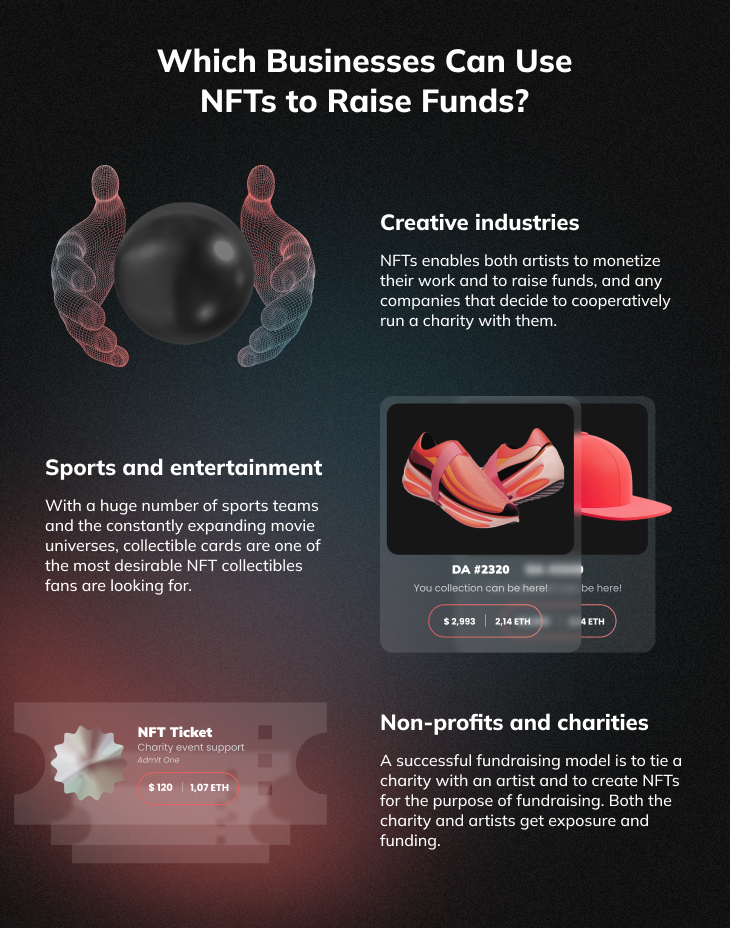

It might be hard to imagine how it works to get someone interested in your idea to the point where they create NFTs for your charity. Looking at huge brands that have done exactly that might help. After all, not every industry will thrive in this modern fundraising method. But again, this depends on many factors. While the real estate industry can tokenize (virtual) properties, is the craze about those as big as it is for sports yet? Following are five examples to show you how these three industries have been successfully implemented in fundraising events, and how they work better than other industries.
Establishing an NFT fundraising platform is not only for charities but as we established, big industries and brands can and have in fact used that for their benefit. This is a good way to embrace a new type of technology, to show that your company has a forward-thinking mindset and lead your business into a new world of opportunities. The benefits are many and one that most big brands seek is the big audience that they can get through NFTs. People from all over the globe can support the cause using their online presence and knowledge of NFTs, and if they lack that, the internet is a perfect way to learn about it. There are many other reasons why big brands would use NFTs to raise funds. These five examples will show you how using NFT for charity has worked successfully for them.
Adidas launched an NFT drop called Into the Metaverse on 17th December 2021. This was a collaboration between Adidas and NFT giants Bored Ape Yacht Club, Punks Comics and GMoney. The minting was at first only available to a smaller community in the early access stage, which offered 20,000 out of the 30,000 available NFTs. The only people who could mint an Adidas NFT in the early access stage were those, who already had an NFT from (at least) one of the three partners.
The reason behind this drop wasn’t anything else but, as Adidas’ Senior Designer Future Andrea Nieto said, “seeking to be a community first”. What looks like a business expansion first begins in November 2021 by buying 144 plots in the virtual Metaverse platform The Sandbox. Then, Adidas announced a partnership with the cryptocurrency exchange platform Coinbase a couple of days later. Almost a month later they announced the Into the Metaverse NFT drop.
WEN? EARLY ACCESS MINTING STARTS NOW
— adidas Originals (@adidasoriginals) December 17, 2021
👉 https://t.co/8l8dPwbZWG
First look of the collaborative NFT with @gmoneyNFT @punkscomic and @BoredApeYC
Good luck and #TracksuitUp pic.twitter.com/REYOSdRbNT
The NFT collection was sold out within minutes, but for the time when it was actually active. Because there were technical complications, the selling period stretched to a couple of hours with waiting times. Overall, the sale accumulated Adidas more than $22 million worth of NFTs. Adidas successfully sold 29,620 NFTs with 380 of the total 30,000 held onto by Adidas and partners for future events. After the first phase was completed, the second phase was introduced, where Adidas NFT holders were able to claim physical merch. All of these NFT holders were given a mysterious airdrop under the form of an NFT capsule which could be opened in the Unboxed phase. A special feature is the Adidas PFP Styling Tool, where holders of Adidas Virtual Gear can style their Bored Ape Yacht Club, WAGMI United and Inhabitants NFT profile pictures with their Adidas NFT gear.
The UK World Wildlife Fund is the perfect example of how raising funds through NFTs can go wrong. It is important to look at this example to know what businesses really need to look out for when trying to raise funds through the crypto community.
The WWF is all about “helping local communities to conserve the natural resources they depend upon; transforming markets and policies towards sustainability; protect and restore species and their habitats”. Naturally, you would expect any cause of theirs to be meaningful and to have a big impact. In principle, that is exactly what their Tokens for Nature project was all about. The project featured 13 endangered species like the Tapanuli orangutan, the African wild dog or Bornean elephant. They launched the project with the hopes to raise money for conservation efforts like stopping climate and nature crises and protect “cherished wildlife” through selling NFTs. And here’s where the whole project failed.
Because their values lie behind sustainable innovations, both the crypto community and sponsors of the Tokens for Nature project were drawn back after realising the impact that NFTs can have on the environment. WWF-UK released the NFTs under the Polygon blockchain and presented it as an eco-friendly option for the release. Based on their calculations, falsely, one transaction would have the equivalent carbon emissions of a glass of tap water. Some experts quickly jumped on the Twitter discussion to share a professional thoughts on the matter.
Just 24 hours to go… ⏳
— WWF UK (@wwf_uk) February 2, 2022
Our #WWFTokensForNature focus on 13 endangered species 🐼🦧🦍
Releasing our NFTs on the eco-friendly @0xPolygon blockchain, each transaction has the equivalent carbon emissions of a glass of tap water.
Join the discussion: https://t.co/T6l20zFpnA pic.twitter.com/urFOjZRDE7
The Social Alpha Foundation (SAF) thrive to (not only) “fund promising projects that accelerate the use of blockchain technology for social good”. On 20th March 2021, for the duration of two days, they launched The Carbon Drop. This NFT campaign was started to support the Open Earth Foundation, a US-based non-profit which currently raises funds to transparently track the global progress of the Paris Agreement. This agreement is an international settlement which brings nations together to cover climate change mitigation, adaptation and finance.
The question is, with the WWF backlash for carbon offprint, how can SAF go around this? Being a foundation about developing innovative open digital infrastructure for improved management of our planet, this could be deemed quite challenging. The RNDR network contributed 500 CO2e tons of carbon offsets in the form of NFTS, provided by Creol.io. The event in return supports the Madre de Dios Peruvian forest conservation project.
Dear friends, my very recent #NFTdrop to support @Open__Earth on @niftygateway just sold for $327,777.00 to @illestrater_ !!! This very meaningful charity drop is my most valuable NFT art piece! I’m deeply honored!! Thank you @illestrater_ for bringing trust and value! pic.twitter.com/6y6zZg8T3j
— Refik Anadol (@refikanadol) March 23, 2021
There are eight artists participating in the cause, and headlining is Beeple. This artist is one of the biggest names in the NFT industry with works like Everydays: the First 5000 Days which was sold for $69 million. The other notable artists are Refik Anadol, Andres Reisinger, Kyle Gordon, FVCKRENDER, GMUNK and Mieke Marple. In total, the campaign was able to secure $6.6 million to fund the Open Earth Foundation.
The United Nations Children’s Fund, or UNICEF, as most might know it, launched the Patchwork Kingdoms NFT project in March 2022. The raised funds went towards UNICEF’s Global Office of Innovation, but most importantly to Giga. A UNICEF-ITU initiative, Giga “maps school and their connectivity levels” and connects those schools in need to the internet. This provides young people with the opportunity to develop their digital skills and access important online learning content.
Giga launched in 2019 and has so far mapped over 2,100,000 schools. From those, over 5,561 have been connected to the internet from 20 countries. Through Giga and its partners, over 2,1000,000 students have been given the chance to tap into the online learning potential. How exactly does UNICEF’s Patchwork Kingdoms NFT project help with that?
In order to commemorate UNICEF’s 75th anniversary, the agency launched 1,000 NFTs to support digital connectivity among schools in underserved communities.https://t.co/ehor2z9liZ
— Patchwork Kingdoms + NFT 2.0 (@PatchworkGiga) February 1, 2022
Join the discord: https://t.co/dCEKJEAJcL
Join the club: https://t.co/7S7z8MOBXC
The NFT collection produced 1,000 data-driven NFTs. Data-driven? This part comes into the artwork itself. The data visualization scientist and artist Nadieh Bremer from Snocrash Labs is the mind behind those visually appealing NFTs. Each NFT represents a kingdom, with an above and below world, almost like two kingdoms reflecting each other. The above part represents connected schools and the opposite represents unconnected from the rich internet schools. The data behind those NFTs is collected from more than 280,000 schools from 21 countries, each NFT representing a subset of those.
The Patchwork Kingdoms project was released and sold out entirely within three hours. The project raised $550,000 dollars. Due to additional secondary sales on the OpenSea platform, the project raised additional funds, totalling $700,000.
MAC Cosmetics and the Keith Haring Foundation launched the VIVA GLAM x Keith Haring NFT collection from 10th April to 1st June 2022. VIVA GLAM is MAC Cosmetics’ Campaign which aims to fund and raise awareness for HIV/AIDS programs. The campaign has always worked together with big names, recently with Lady Gaga and Rosalía, to release yearly capsule collections of lipsticks and lip glosses for the support of the campaign.
In 2022, that big name was the late Keith Haring. Haring is an American iconic artist and activist, part of the legendary 1980s New York art scene. His work is known to respond to modern social and political events which has to this day remained a constantly spreading and recognized visual language. Keith Haring was diagnosed with aids in 1988, a year later he established the Keith Haring Foundation and unfortunately passed away in 1990. His foundation is still active to this day and has always been fighting to provide funding and imagery to AIDS organizations and children’s programs.
Empower our future this National Youth HIV/AIDS Awareness Day with three collectible and charitable NFTs that give back 100% to local organizations supporting youth living with or affected by HIV/AIDS. #MACVIVAGLAM #MACKeithHaring @keithharingfdn @artestarnyc pic.twitter.com/HPRwiJupOY
— maccosmetics (@MACcosmetics) March 29, 2022
The different concept for VIVA GLAM’s 2022 project is that they tapped into the metaverse world and NFTs for the first time ever. The NFT collection came in three variants, offering animations of the MAC VIVA GLAM lipsticks decorated with Keith Haring’s artwork. The NFTs were available in three different rarity and price levels, from $25 to $1,000 each, inviting a wider community to support the cause.
The project donates 100% of the purchases to the MAC VIVA GLAM Fund, and through 15 January 2023, 2.5% of the secondary sales on OpenSea went to The Keith Haring Foundation. There are no available stats as to how much the cause has raised because it is still active.
Also learn more about NFT Gallery – The Future of Presenting Digital Art.
The best starting point for any business is truly understanding the cause you are getting into. Understanding non-fungible tokens is vital in order to set up a successful NFT fundraising platform. Apart from that, it’s important to look at the past and current trends. Then, look at what popular platforms and marketplaces there are, how does each operate and which one is best for you. But how can you know what is best for you? By knowing what your business needs!
Knowing what your business needs is important in order to decide where and what to look into. Evaluate your needs, what kind of funding you would need and where it would go to. Have a clear message behind your charity, one that people can and will support, and have a clear structure in the overall organization.
Something else that you would obviously need is the actual NFTs. Knowing what your message and values are, what kind of NFTs could you create to depict those in the best visual way possible? Outstanding NFT collections usually include limited edition collectible NFTs, and exclusive content to NFT holders and depending on your industry, virtual experiences are also a good idea. Think of the Adidas example from earlier and their Metaverse presence.
What’s left for your charity now is purely strategic and communication-based. It is totally in your control and how you want the outcome to be shaped. Thinking about the pricing of your NFTs should be based on previous records and current trends, what would their value, rarity and trendiness be? After that, you would need to properly and actively find the stage to promote your cause in the digital world, which will surely work for your benefit given the wide audience. Most important of all is to stay true to your values and message and to provide your audience with the experience that you had in mind, whilst raising funds for your cause.
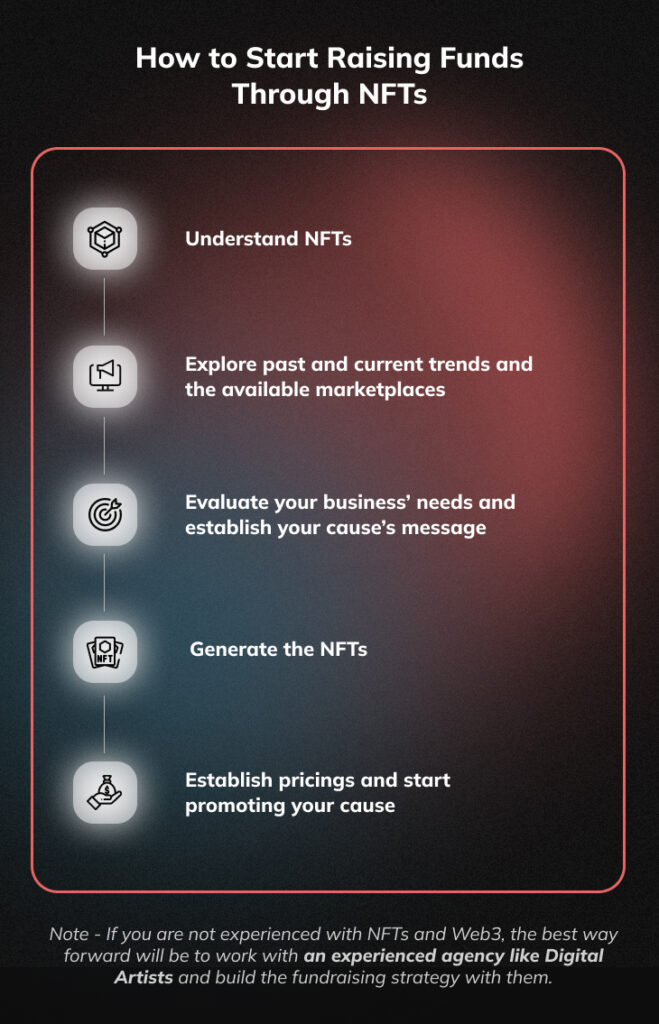
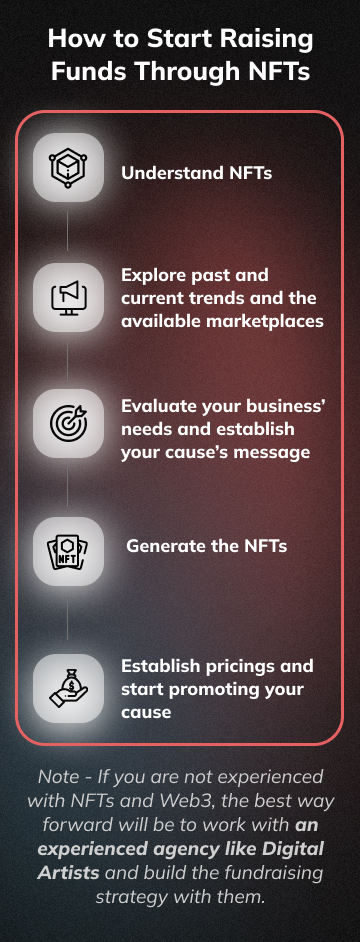
The most common mistakes people make when using NFTs for a fundraiser campaign are easy to oversee when looking at the bigger picture. But knowing that these are important aspects of any fundraising campaign is as important as its outcome, after all, one can’t succeed without the other.
When a community forms around a cause/charity that it believes in, it becomes easier for that respected charity to reach a wider audience, be it from word of mouth or the power of social media. Almost every person has an online presence and network and can share their message with that network. Having a community around your cause can also be beneficial for feedback. They will visibly show if your campaign is doing good or not in every aspect. And this, sometimes, without you even asking for it. What’s probably most important about having a community is the fact that it can become your long-term/lifelong supporter.
If you have a well-structured plan for your charity, it will become much easier to share your message with investors. It will also show some attitude to them because of the confidence it can project in knowing why you are raising funds and how these funds will be utilized.
If you show everyone that you have the right intentions, you’re more likely to succeed. You will establish trust and are going to be transparent with your investors about their funds and what you do with it. Another side is that overall, whatever reputation your campaign accumulates, that’s what’s going to be projected onto your supporters and community. So, it’s important to have the right intentions because it’s not only you on the line in case of an unsuccessful run.
By carefully considering those usual mistakes, you are more likely to help both yourself and your business by running a successful NFT fundraising campaign.
This NFT fundraising guide has covered many essential topics on how selling NFT for charity can be beneficial and successful for your business. By looking at some good and bad examples of what NFTs can do for your fundraising cause, you should have an idea of what to do and what to avoid.
Using NFT for fundraising is slowly replacing the traditional fundraising model. To some communities, it already is the “modern” way to donate to organizations. But it is still long away from being a worldwide “contemporary” fundraising strategy. People are still learning what NFTs are in the first place, let alone how to navigate them and how to do to support different causes. With that being said, every business that is coming out with this type of charity fund now will be deemed innovative and forward-thinking, while things are still fresh. More businesses and people will become familiar with the whole technology in the near future and NFT-based funding might see an even bigger implementation.
The unstable market, and the fact that it is sometimes dependent on the “hype” around an NFT drop, makes the usage of this technology very unreliable and unstable in some cases and at certain times. But there is no overlooking the power that collaborations, global communities and the digital world altogether have, and this might be pushing NFT charities to be the preferred way in the future.
Now, regardless of whether you reached this point after reading the whole guide or you just skipped it, here we have all the information above summarised in six punchy and packed with insight frequently asked questions:
Traditional fundraising uses physical events or donation points to raise money and awareness to a certain cause, sometimes excluded to a limited (local) community. Now take that, and bring it online, instead of taking cash you provide the sponsors with the option to donate through NFTs and you get an advanced way to raise money for your cause.
You could donate any NFT that you own to pretty much anyone with a wallet address. Once you have the recipient’s public wallet address, you could send them as many NFTs as you wish to. Of course, there are gas fees that you have to pay for each transaction, so it might be good to donate in bulk.
One of the biggest advantages of using NFTs for a fundraising organization is the worldwide reach that they offer. There is a global tech community which believes in and pushes the crypto communities forward, which are the best investors for any NFT-based charity.
One of the most common mistakes which people make when using NFTs for funding their business is to not build a community. The importance of having a tech-savvy and truthful community can have many benefits like long-term support, honest feedback and free and quick sharing of your cause with their existing networks.
Some of the largest NFT-based fundraisings are truly remarkable. Adidas, who raised $22 million in just minutes after launching, sold a total of 29,620 NFTs. The SAF launched The Carbon Drop for the Open Earth Foundation, which secured $6.6 million to fund the transparent track of the Paris Agreement’s global progress.